Related Research Articles
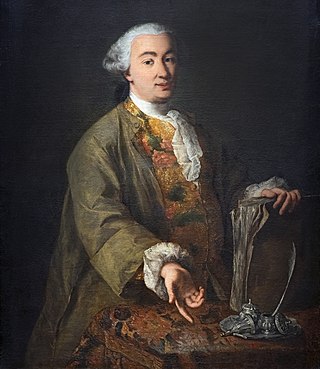
Carlo Osvaldo Goldoni was a Venetian playwright and librettist. His works include some of Venice’s most famous and best-loved plays. Audiences have admired the plays of Goldoni for their ingenious mix of wit and honesty. His plays offered his contemporaries images of themselves, often dramatizing the lives, values, and conflicts of the emerging middle classes. Though he wrote in French and Italian, his plays make rich use of the Venetian language, regional vernacular, and colloquialisms. Goldoni also wrote under the pen name and title Polisseno Fegeio, Pastor Arcade, which he claimed in his memoirs the "Arcadians of Rome" bestowed on him.
Anderson is a city and county seat of Grimes County, Texas, United States. The population was 193 as of the 2020 census. The town and its surroundings are listed on the National Register of Historic Places as the Anderson Historic District.

Tiverton is a town and civil parish in Devon, England, and the commercial and administrative centre of the Mid Devon district. The population in 2019 was 20,587.
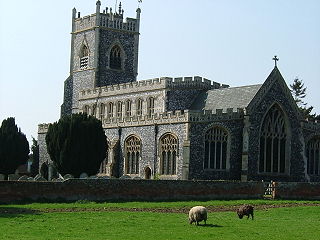
Stratford St. Mary is a village in Suffolk, England in the heart of 'Constable Country'. John Constable painted a number of paintings in and around Stratford.

Uffculme is a village and civil parish located in the Mid Devon district, of Devon, England. Situated in the Blackdown Hills on the B3440, close to the M5 motorway and the Bristol–Exeter railway line, near Cullompton, Uffculme is on the upper reaches of the River Culm. The population of the parish, according to a 2020 estimate, is 3,090. It is surrounded, clockwise from the north, by the parishes of Culmstock, Hemyock, Sheldon, Kentisbeare, Cullompton, Willand, Halberton and Burlescombe.

Eleanor Coade was a British businesswoman known for manufacturing Neoclassical statues, architectural decorations and garden ornaments made of Lithodipyra or Coade stone for over 50 years from 1769 until her death. She should not be confused or conflated with her mother, also named Eleanor.

The 1977 anti-Tamil pogrom in Sri Lanka followed the 1977 general elections in Sri Lanka where the Sri Lankan Tamil nationalistic Tamil United Liberation Front won a plurality of minority Sri Lankan Tamil votes in which it stood for secession. An official government estimate put the death toll at 125, whereas other sources estimate that around 300 Tamils were killed by Sinhalese mobs. Human rights groups, such as the UTHR-J, accused the newly elected UNP-led government of orchestrating the violence. The majority of victims were Tamils.

Dedham is a village in the City of Colchester district of Essex, England. It is near the River Stour, which is the border of Essex and Suffolk. The nearest town to Dedham is the small market town of Manningtree.

Tiverton High School is a state secondary school located in Tiverton, Devon, England. It is located on the outskirts of the town, and has a close working relationship with the co-sited Petroc.

Ross is a village in the Midlands of the state of Tasmania in Australia. On the Macquarie River, Ross is located 78 km south of Launceston and 117 km north of Hobart. The town is listed on the Register of the National Estate and is noted for its historic bridge, original sandstone buildings and convict history.
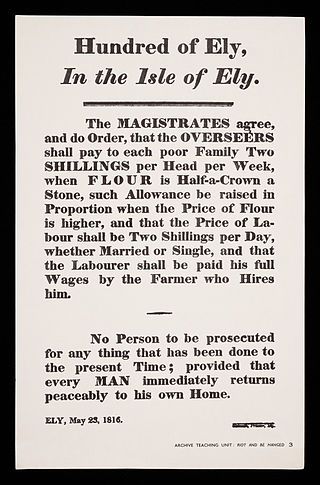
The Ely and Littleport riots of 1816, also known as the Ely riots or Littleport riots, occurred between 22 and 24 May 1816 in the Isle of Ely. The riots were caused by high unemployment and rising grain costs, similar to the general unrest which spread throughout England following the Napoleonic Wars.
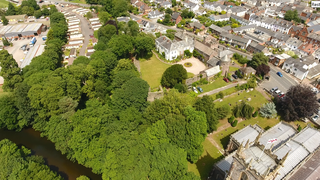
Tiverton Castle is the remains of a medieval castle dismantled after the Civil War and thereafter converted in the 17th century into a country house. It occupies a defensive position above the banks of the River Exe at Tiverton in Devon.
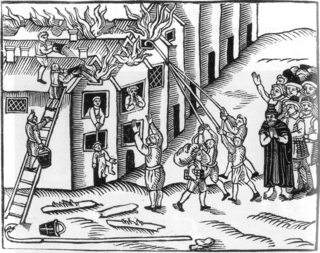
The Tiverton fire of 1731, also known as the Great Fire, was a fire that affected part of Tiverton, Devon in England on 5 June 1731. It was one of a number of serious fires affecting the town in the 17th and 18th centuries. Breaking out in a baker's house in Gold Street, the fire spread rapidly due to the prevalence of straw-thatched roofs in the town. In total 298 houses were destroyed in the fire which caused damage to the value of an estimated £58,976 14s. 9d. In response to the fire, a number of benefactors came forward to assist Tiverton in rebuilding. The fire resulted in the introduction of legislation that attempted to prevent a similar incident happening in the future.
Martin Dunsford (1744–1807) of Tiverton in Devon, was an English merchant and Dissenter, known as an antiquarian and radical politician. His work Memoirs of the Town and Parish of Tiverton is noted as an attempt to write of the town as a whole community.

Coldharbour Mill, near the village of Uffculme in Devon, England, is one of the oldest woollen textile mills in the world, having been in continuous production since 1797. The mill was one of a number owned by Fox Brothers, and is designated by English Heritage as a Grade II* listed building.

Original Maryborough Town Site is a heritage-listed archaeological site at Russell Street, Maryborough, Fraser Coast Region, Queensland, Australia. It was added to the Queensland Heritage Register on 4 September 2007.

George Slee of the Great House, Peter Street, Tiverton, Devon, was a wealthy wool merchant and clothier. He founded Slee's Almshouses in Tiverton, the building of which survives next to the Great House in Peter Street. His ornate chest tomb survives in St Peter's Church, Tiverton.

Merchant's House is a heritage-listed education centre and offices, that was formerly a residence, museum, offices and boarding house, located at 43–45 George Street in the inner city Sydney suburb of The Rocks in the City of Sydney local government area of New South Wales, Australia. Its design is attributed to John Bibb and was built during 1848. It is also known as Counting House (former) and Merchant's. The property is owned by Property NSW, an agency of the Government of New South Wales. It was added to the New South Wales State Heritage Register on 10 May 2002.

John Greenway was a wealthy wool merchant of Tiverton in Devon who is chiefly remembered for his surviving building works in that town, namely the Greenway Chapel and the Greenway Porch in St Peter's Church, and the Greenway Almshouse (1517) in Gold Street. He was a member of the Company of Merchant Adventurers of London and of the Worshipful Company of Drapers, the arms of which Companies adorn the Greenway Chapel. He is one of the Worthies of Devon of the Devonshire biographer John Prince (1643–1723).
References
 This article incorporates text from this source, which is in the public domain : Martin Dunsford 's Historical Memoirs of the Town and Parish of Tiverton (1836)
This article incorporates text from this source, which is in the public domain : Martin Dunsford 's Historical Memoirs of the Town and Parish of Tiverton (1836)
- 1 2 3 4 5 6 7 Dunsford, Martin (1836). Historical Memoirs of the Town and Parish of Tiverton. p. 65-66. Retrieved 12 July 2012.